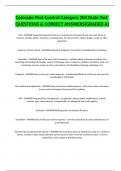Colorado Pest Control Category 304 State Test
QUESTIONS & CORRECT ANSWERS(GRADED A)
Pest - ANSWER Unwanted organisms that are a nuisance to man/animals and can cause injury to
humans, animals, plants, structures, or possessions. Can be an insect, rodent, fungus, weed, or other
organisms.
Sequence of Pest Control - ANSWER Inspection, Diagnosis, Prescription and Application, Evaluation
Inspection - ANSWER Step in the pest control sequence - Includes asking customers questions and
examining the building thoroughly. Look for harborage areas, conducive conditions (moisture, heat, etc),
food/water sources, means of entry, and evidence of infestations (damage, droppings, etc)
Diagnosis - ANSWER Step in the pest control sequence - Includes identification of the pest and any facts
contributing to infestation.
Prescription and Application - ANSWER Step in the pest control sequence - what, how, when, and where
to use control techniques that correct the problem.
IPM - ANSWER Integrated Pest Management - an approach where habitat modifications, cultural
controls, pest control devices, and pesticides are integrated and used together.
Exclusion - ANSWER Blocking points of entrance for pests.
Evaluation - ANSWER Step in the pest control sequence - periodic inspections to assess effectiveness of
prescribed plan.
Hand Carried Compressed Air Sprayer - ANSWER The most basic piece of equipment, used on a variety of
insects; includes a tank, pump, tube that carries spray to hose, hose that connects to tank, a valve to
control flow, and a nozzle to distribute spray.
, Canned Aerosol Pesticides - ANSWER These products produce an aerosol or fog droplet that floats in the
air for a period of time and then settles. The droplets kill pests on contact or if insects fly/move into
treated area.
Aerosol and Fog Generators - ANSWER Break liquid pesticides into aerosol droplets through either
mechanical means (cold fogging) or heat (thermal fogging).
Cold Foggers - ANSWER Break insecticide into aerosol-sized droplets and propel them into the air as a
"fog". Examples are ULV and ULD. Generally used to fill rooms and small warehouses to kill flying and
exposed insects. Fogs do not enter cracks/crevices.
Thermal Foggers - ANSWER Us heat to vaporize oil-based insecticide formulations, operating similarly to
cold foggers but with smaller droplet size.
REI - ANSWER Re-entry interval, the time set before people or pets reoccupy treated areas.
Dusters - ANSWER Used to apply dust, pesticides in dust sit on surface and accumulate on insect body
parts. They are either absorbed or ingested when insects groom themselves.
Traps - ANSWER Used for centuries, includes rodent snap traps; small animal traps; rodent bait boxes
and bait traps; fly traps; electric fly traps; sticky traps; pheromone dispensers; and so on. Can catch/kill
populations and can also be used for monitoring.
Label - ANSWER IT IS THE LAW. includes all written, printed, or graphic material accompanying the
pesticide. Must have label in possession when using a product.
Labels Must Contain - ANSWER Brand name, use classification, ingredient statement, registered uses,
directions for use, safety information, signal word, precautions, net contents, name and address of
manufacturer, and EPA registration number.
Directions for Use - ANSWER Indication on label of where the product can be used and what pest can be
targeted. Also gives application methods and dosage rates.




